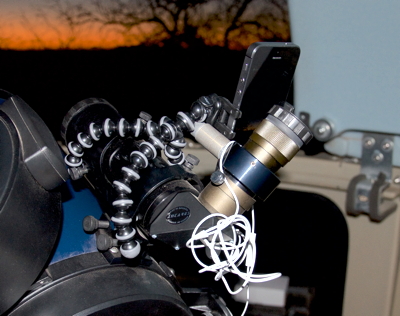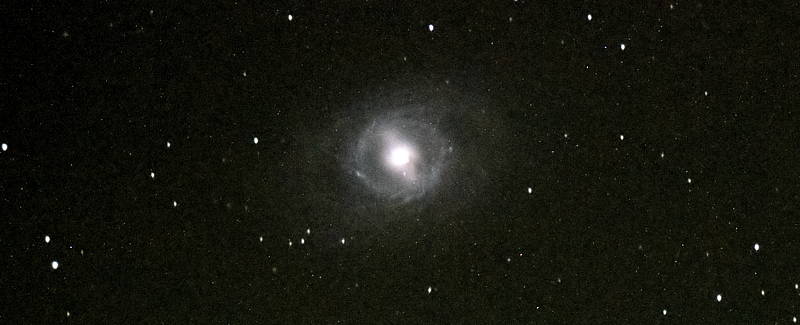iPhone 5s Zodiacal Light; D7000 DSLR Jupiter tests, M95, M96
Posted: 10 February 2015
|
Open: Monday, 9 February 2015, 1815 MST Temperature: 78°F |
Session: 780 Conditions: Clear |
1823 MST: viewed Venus, 83X. Then began working with the GorillaPod to mount the iPhone 5s piggyback on the 8" LX200-ACF. I could have used the tripod mounting mode of the MX-1 Afocal Adapter but wanted to try the GorillaPod as it is more of a universal piggyback solution. I found the GorillaPod difficult to securely hold the iPhone on the finderscope but finally was able to brace it as seen here:


The white Earbuds/Mic volume control is being used as a remote shutter release.
This iOS Camera photograph of the western sky shows the piggybacked view from inside the observatory, with Venus visible just below center:

I then used NightCap Pro set for Long Exposure and Light Boost for these piggybacked tracked 5 minute (left) and 10 minute (right) photographs of the western sky:


Venus is at the bottom with Mars just above it. The Zodiacal Light is faintly captured in both images, although it appears somewhat brighter in the 5 minute (left) image. While not as good as with a DSLR camera (as seen on the previous report), it is amazing that a smartphone can be used (with help from NightCap Pro) to photograph the faint Zodiacal Light.
2000 MST: viewed Jupiter, 83X. Four moons were visible. Began setting up for eyepiece projection imaging of Jupiter using a OPT Camera Adapter with the D7000 DSLR. First I used a 9mm (222X) eyepiece. Did a focus test on Regulus using the Bahtinov Mask. I then did HD video recordings at various exposure settings. This is a stack of 579 frames, 222X, 1/60sec, ISO 4000:

I added a 2X PowerMate to yield 444X. These iPhone photos of the D7000 DSLR "live view" screen show how Jupiter appeared at 222X (left) and 444X (right):


This image is a stack of 561 frames, 444X, 1/30sec, ISO 4000, and is reduced 50%:

It was necessary to reduce the image scale to minimize digital artifacts that appeared when sharpening the image. I ended Jupiter imaging tests at 2051 MST. I plan to do more tests afocal 444X to try to reduce the artifacts.
Next, I prepared the D7000 DSLR for prime focus Deep Sky Object (DSO) imaging. Switched to using the off-axis guider. 2058 MST: viewed Jupiter, 83X. Nice view. Then slewed to M95 (galaxy). It was visible at 83X but was currently too low in the sky for imaging. Also viewed M96, 83X, also too low for imaging.
While waiting for M95 and M96 to rise higher I did some Sky Quality Measurements of my night sky. At 2125 MST, the Unihedron SQM-L reported 20.96. I submitted the result to the GlobeAtNight. I also submitted a report using the iOS app "Loss of the Night".
2150 MST: attached the D7000 DSLR at prime focus of the 8" telescope using the off-axis guider. Did a focus test with the Bahtinov Mask using Regulus. I then did some 1 minute framing test exposures of M95, finally locating a good guide star. This is a cropped, guided 10 minute, ISO 5000, image of the M95:

I slewed to M96, found a faint guide star and did a 1 minute framing test exposure. This is a cropped, guided 10 minute, ISO 5000, image of M96:

I then slewed to NGC4151 (galaxy) and did some framing test exposures while trying to find a good guide star. I could not find a guide star and the rising waning gibbous moon was now brightening the eastern sky. So I ended DSO imaging at 2258 MST. I will try to image NGC4151 on a future session.
2313 MST: viewed NGC4151 (galaxy), 83X. It was very faint.
|
Close: Monday, 9 February 2015, 2324 MST Temperature: 55°F |
|
Comments are welcome using Email. If you are on Twitter you can use the button below to tweet this report to your followers. Thanks.
Cassiopeia Observatory Home Page
Copyright ©2015 Michael L. Weasner / mweasner@me.com
URL = http://www.weasner.com/co/Reports/2015/02/10/index.html
